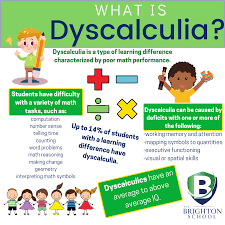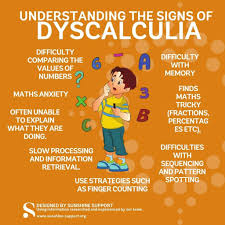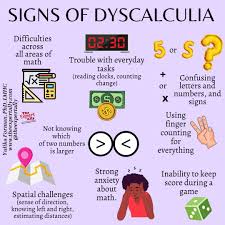Understanding Dyscalculia: Early Signs and Effective Interventions
Dyscalculia is a specific learning disability that affects a person’s ability to understand and manipulate numbers. It is often compared to dyslexia, but while dyslexia impairs reading skills, dyscalculia primarily impacts mathematical abilities. This condition can make everyday tasks, such as managing finances, telling time, or understanding measurements, particularly challenging. Identifying dyscalculia early and implementing targeted interventions can significantly help individuals manage its effects.


Early Signs of Dyscalculia Recognizing dyscalculia in its early stages is crucial for providing timely support. Some common early signs include:
Difficulty Understanding Numbers – Children may struggle with basic number concepts, such as counting, recognizing numbers, or understanding their value.
Challenges with Basic Arithmetic – Difficulty in performing simple addition, subtraction, multiplication, and division problems.
Problems with Number Sequences – Struggling to remember sequences of numbers, such as phone numbers or counting in order.
Trouble with Time and Measurements – Difficulty reading clocks, understanding schedules, or estimating lengths and quantities.
Difficulty in Pattern Recognition – Problems identifying and continuing number patterns or understanding relationships between numbers.
Poor Mental Math Skills – Difficulty performing calculations mentally, even simple ones.
Anxiety and Avoidance – Showing signs of frustration, anxiety, or avoidance when faced with math-related tasks.
Effective Interventions for Dyscalculia While dyscalculia cannot be cured, various interventions can help individuals develop better mathematical skills and coping strategies. These include:
Multi-Sensory Learning Approaches – Using visual aids, physical objects (such as counting blocks), and interactive technology to reinforce mathematical concepts.
Structured and Repetitive Practice – Providing consistent, structured practice with step-by-step instruction to reinforce learning.
Use of Assistive Technology – Employing apps and tools, such as calculators, number lines, or specialized software, to support numerical understanding.
One-on-One Tutoring and Special Education Support – Working with educators trained in dyscalculia to develop personalized learning strategies.
Real-Life Math Applications – Encouraging practical math use in daily activities, such as cooking (measuring ingredients) or shopping (handling money).
Encouragement and Positive Reinforcement – Building confidence through praise, rewards, and reducing anxiety associated with math tasks.
Cognitive and Memory Training – Enhancing working memory and problem-solving skills through games and exercises designed to strengthen cognitive abilities.

Conclusion Dyscalculia is a lifelong condition, but early identification and targeted interventions can help individuals overcome many of its challenges. With the right support, those affected can develop strategies to improve their mathematical understanding and enhance their confidence in handling numerical tasks. Raising awareness about dyscalculia ensures that children and adults receive the necessary help to succeed in both academic and everyday settings.
Free Screening Tools and Resources
Early identification of dyscalculia can be aided through various free online screening tools and resources. Some useful websites include:
Dyscalculia Screener by Dyscalculia.org – A free preliminary assessment tool to identify potential dyscalculia symptoms.
Understood.org– Provides resources, quizzes, and expert advice on dyscalculia and other learning disabilities.
NumberDyslexia.com – Offers insights, strategies, and interactive tools for individuals struggling with number-related difficulties.
By utilizing these tools and interventions, individuals with dyscalculia can receive the necessary support to navigate mathematical challenges more effectively.

